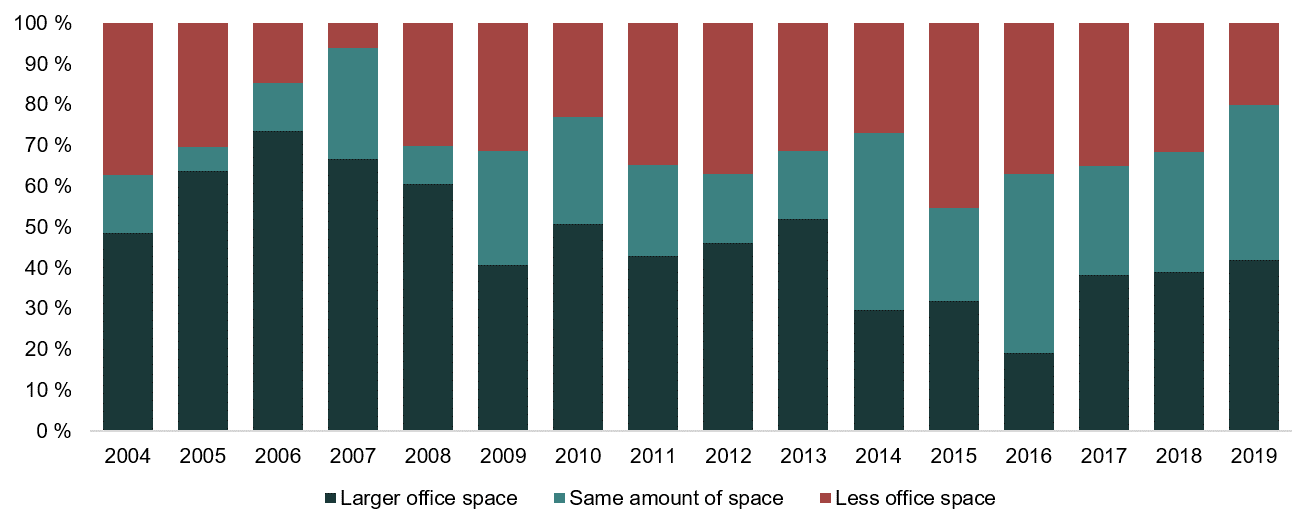
Tenants seek more office space – for the first time in six years
The tenants relocating in 2019 seek on average 4% more space than what they currently occupy. This is the first time since 2013 that the change in net demand for office space is positive. The increase in demand is mainly driven by the smaller tenants who on average seek 10% more space, while the larger tenants seek no change in office space.
Key observations from the 2019 Tenants Relocating survey:
- The tenants who are relocating in 2019 seek on average 4% more space than what they currently occupy.
- This is the first time since 2013 that the change in net demand for office space is positive.
- The share of respondents who seek a smaller office space is the lowest since 2007.
- The share of respondents seeking less space per employee is also at its lowest since 2007.
- Small-to-medium office users (<5,000 sq. m) expand more than larger ones, and large office users seek increased space efficiency to a stronger degree than the smaller ones.
Summary of the Tenants Relocating survey structure
Akershus Eiendom has executed its 16th annual survey of companies or government / municipality agencies currently in the process of relocating. The respondents have either signed a new lease contract during 2019 or are actively in the process of finding new office premises.
- Designed to map the demand side of the office market, the survey collects a solid sample of observations of current trends in the market. The survey provides a forecast for actual new absorption in the coming 6-18 months, as few have relocated at the time of the survey.
- In 2019, the 50 tenants surveyed are in the process of acquiring 163,400 sq. m of office space in Oslo. This is a sample size in line with earlier years.
- In the survey, the trends are distributed evenly across the sample regarding size, as larger respondents tend to skew the overall results.
- The survey was performed during the first weeks of September 2019.

The survey results: Good news for landlords
In the 2019 survey, the tenants seek on average 4% more space than they currently occupy. This is the first time since 2013 that the net demand growth for new office space is positive. The increase in demand is mainly driven by the smaller tenants who on average seek 10% more space than they currently have, while the larger tenants on average seek no change in office space.

Looking at the distribution of what office size the tenants seek when relocating, the positive net demand growth fits well with the observation that 42% of the tenants seek larger office space than what they currently occupy. As displayed in Figure 2, this is the highest level recorded since 2013. At the same time the portion of tenants seeking less office space is at its lowest level since 2007, with 20%.

Comparing the two groups of tenants, we observe a clear distinction in their demand for office space; While the tenants occupying less than 5,000 sq. m on average seek 10% more space, the larger tenants seek to keep their office space stable. This divergence can be explained by differences in how they see their number of employees going forward and in their demand for space per employee.
Among the surveyed tenants, 50% reports change in number of employees to be the main reason for relocating. As can be seen from Figure 3, 60 % of the tenants expect to increase their staff in the coming year. This is the highest level recorded since 2013, and 20 percentage points higher than in last year’s survey. The trend is similar between the two groups of tenants, with 75% of the larger and 57% of the smaller expecting more employees over the next 12 months. The expectance of more employees should increase the demand for office space. This is in line with 76% of the surveyed tenants who reports that they seek larger premises due to increase in staff.

However, the demand for space efficiency also decides the total demand for office space. Figure 4 shows the distribution between the tenants’ demand for space per employee. While the trend among most tenants has been to reduce space per employee over the past years, 64% of the tenants in 2019 seek no change in space per employee. The trend differs between the two groups of tenants; 69% of the smaller tenants seek no change in space efficiency, while 63% of the larger tenants seek to adopt less space per employee.

Interpretation of the results: Less focus on efficiency
Now that the trend of adopting open plan offices has been around for some time, a larger portion of companies searching for new office space might already be seated quite efficiently. Hence the high proportion of tenants responding no change in seating, especially for the respondents with less than 5,000 sq. m. The efficiency trend is also now more common in larger government and municipality organisations and more conservative businesses, which keeps demand for new and efficient office space high.
To summarize, the diverging growth in demand for office space between larger and smaller tenants is explained by their expected hiring activity and their plans for seat efficiency when relocating. For the smaller tenants, the majority expect more staff going forward and at the same time they seek no change in seat efficiency. Thus, the net demand effect is positive and accounts to a 10% increase.
For the larger tenants, the majority expect more staff going forward but seek at the same time increased seat efficiency when relocating. The result is no change in net demand for office space, as the increased seat efficiency neutralizes the positive demand effect from increasing the staff.
Going forward: Expectations for 2020
We expect efficiency issues to remain slightly less pressing for 2020, and growth in demand to be somewhat weaker than 2019, based on expectation surveys plus GDP forecasts, which uniformly point to a weaker 2020 compared to this year. The divergence between small and large office users is expected to continue, as it appears to be a long-term trend.